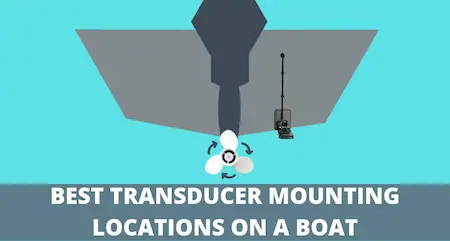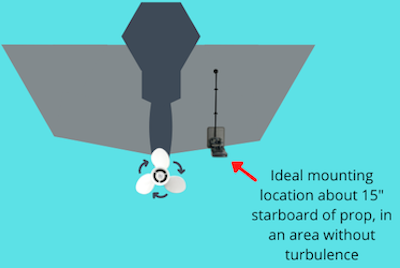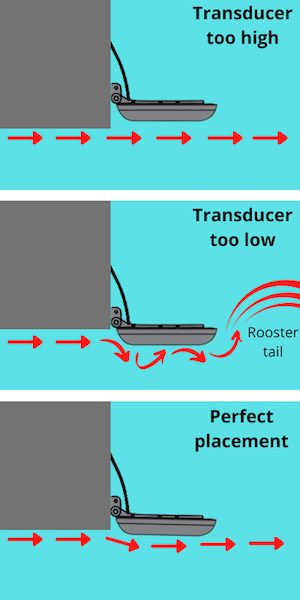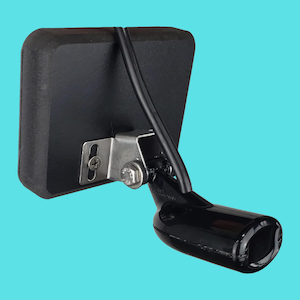Where Is The Best Place To Mount A Transducer? (Top 5 Locations)
UPDATED 03 NOVEMBER 2023
by Robert Ceran
Are you wondering where to mount your fish finder transducer?
As you probably know, it’s essential to install your transducer correctly in order to get good performance from it.
But choosing the right location to mount a transducer is more complicated than most people anticipate, since each location comes with its own set of challenges and pros and cons.

In this article we’ll go over the 5 best places to mount a transducer on a boat, and what you need to know in order to choose the right location for your transducer.
Where to mount a transducer on a boat
The top five transducer mounting locations on a boat are:
- Transom mount
- Trolling motor mount
- In-hull mount
- Pole mount
- Thru hull mount
Out of these five transducer placement options, the most commonly used ones by far are transom and trolling motor mounts, though the other three can also be great options for specific situations and applications.
When choosing the right transducer mounting location, it’s important to keep in mind that all of these options come with their own pros and cons, and you should weigh these carefully before choosing the right one for your purposes.
Where to mount transducer on transom
Now let’s talk about choosing the best transom mount transducer location, since this is one of the most commonly used places to mount a transducer on a boat.
Unfortunately, many anglers choose an incorrect transducer placement on the transom, and as a result they experience problems with their sonar imaging.
That’s why it’s so important to get the transducer placement right in order to achieve the best results.
What is the best transom mount transducer location?
It’s essential to mount your transducer in an area of the transom that doesn’t have any turbulence, since even a little turbulence can negatively impact the quality of your sonar image.

This means you should avoid areas with turbulent water flow aft of rivets, strakes, or ribs in the hull. Choose a transducer placement spot on the transom where the hull in front of this location is flat and smooth.
Also, make sure that the transducer is at least 15 inches away from the propeller of your outboard motor, and check whether the outboard can rotate fully in all directions without bumping into the transducer (which needs to be checked in the fully trimmed position).
What is the best transducer mounting height?
The best transducer mounting height is at the bottom edge of the transom, with the lower surface of the transducer protruding about 1/32 to 1/16 inches below the bottom of the boat.
It’s important to avoid mounting the transducer too high on the transom, since this will cause it to be out of the water at planing speed (keep in mind that the water level of the transom drops when the boat is on plane).
If you mount your transducer too high on the transom, this will still allow it to function at slow speeds under 2 to 3 mph. But as soon as the boat gets faster than that, the transducer will stop working.

Secondly, you also want to avoid the transducer being too low on the transom, as that will trigger turbulence and rooster tail formation, which also negatively affects the quality of sonar imaging.
So the ideal transducer mounting height on the transom is with the bottom surface of the transducer just slightly protruding below the bottom of the boat (see diagram above).
How far should a transducer be in the water?
The transducer placement needs to be deep enough so that its piezoelectric crystals are fully covered by water.
This can be accomplished even if the top of the transducer is flush with the water level, but if its crystals are out of the water, the sonar can’t function, and you won’t get an image.
One thing you need to keep in mind is that the water level of the transom goes down at planing speed, and if your transducer is mounted too high, the crystals will be out of the water when you’re going fast.
Should the transducer be flush with the bottom of the boat?
No, it’s actually better if the bottom edge of the transducer protrudes by about 1/32 to 1/16 inch below the bottom of the boat.
This is just enough to ensure that it is covered by water even at planing speed, but not low enough to trigger turbulence and rooster tail formation.
If the transducer is flush with the bottom of the boat, it will still work at slower speed, but not at high speeds.
Can you mount a transducer too low?
Yes, if you mount a transducer too low, it will trigger turbulence and air bubble formation around the transducer, as well as rooster tail formation behind the transducer.
This turbulence decreases the quality of the sonar imaging, especially when your boat is planing at higher speed.
What side of the boat do you mount a transducer?
A transducer should be mounted on the side of the boat with the downstroke of the outboard propeller, which is usually on the starboard side.
An easy way to check this for your boat is to observe the direction of rotation of your propeller. If it’s clockwise, then your transducer placement should be on the starboard side, but if it’s anti-clockwise, then the transducer should be on the port side.
The side of the transom with the downward stroke of the prop has less turbulence than the side with the upward stroke, which is why it is the best transducer mounting location.
Where to mount a transducer on trolling motor
The best place to mount a transducer on a trolling motor depends on the type of transducer you’re using.
A forward facing transducer (such as LiveScope, Active Target, or MEGA Live) should be mounted on the shaft of the trolling motor, as that gives it an unobstructed view in the forward direction.
The great thing about this type of transducer mount is that it will automatically point your transducer in the same direction as the trolling motor.
However, you can also achieve this with a trolling motor barrel mount if the transducer is placed on the side of the lower compartment.
If you want to mount a 2D or down imaging transducer on your trolling motor, the best way to do this is with a barrel mount, which uses a circular mounting bracket that fits around the lower compartment of the trolling motor.
This mounting location is ideal for pointing the transducer downwards without obstructing its view.
The best locations to mount different types of transducers
Now let’s take a closer look at different types of transducers, and the best mounting locations for each of them.
Where to mount a side imaging transducer
The best location to mount a side imaging transducer is at the transom, since that usually allows its sonar beams to shoot sideways in both directions while you’re driving the boat around, which enables you to scout large areas of water to both sides without having to slow down.
But when mounting a side imaging transducer on the transom, you need to take care that you put it in a spot where it isn’t blocked on one side by the outboard motor when it is fully trimmed down.
Where to mount a down imaging transducer
The best location to mount a down imaging transducer is either the transom, or the trolling motor.
Which transducer placement is best for you depends on whether you plan to use the down imaging while you’re driving around (in which case a transom mount is best), or while you’re fishing (in which case a trolling motor mount is best).
If you mount your transducer on your trolling motor, the best option is a barrel mount, since that allows you to position it at the very bottom and pointing downwards with an unobstructed view.
Finally, Humminbird offers several thru hull down imaging transducers that you can mount inside your boat without drilling a hole.
This option is great if you want to use down imaging to scan the water below while driving around with your boat at planing speed.
Where to mount a LiveScope transducer
The best location to mount a LiveScope transducer is on the shaft of your trolling motor, which is ideal for a forward facing sonar. This also holds true for other brands of live sonar, including Lowrance Active Target or Humminbird MEGA Live.
However, an alternative option is to use a transducer mounting pole, which was specifically designed for live sonars, and can be positioned at the front of your boat similar to a trolling motor.
The nice thing about using a transducer mounting pole is that you can point your transducer in different directions independently of the trolling motor, simply by rotating the handle of the mounting pole.
The same mounting locations that are ideal for live sonar transducers are also a great choice for Humminbird 360 or Mega 360 transducers.
Where to mount an in-hull transducer
The best place to mount an In-hull transducer is as close as possible to the centerline of the hull and towards the aft end, since this part of the hull remains in contact with the water even at high speed.
If mounted correctly, this transducer location will allow you to get high quality sonar readings at high speed with an in-hull transducer.
But keep in mind that in-hull transducers can only be used on fiberglass boats, since fiberglass has sonar characteristics that are similar to water, which enables an in-hull transducer to shoot its sonar beam through the hull.
When choosing the right location to mount an in-hull transducer, choose an area that has no ribs, rivets, or other protrusions on the outside of the hull, in order to avoid water turbulence.
You also need to avoid locations with cables or other sources of interference.
Where to mount a thru hull transducer
The best place for mounting a thru hull transducer is as close as possible to the centerline of the hull and towards the aft of the boat.
Choosing an aft midship transducer placement ensures that the transducer will be in contact with water even when planing at high speed.
Also, if you have an inboard motor, make sure that the thru hull transducer is mounted forward of the propeller.
Where to mount a transducer on a pontoon boat
The best place to mount a transducer is at the bottom edge of the bracket at the back end on one of the pontoon tubes.
Since pontoon boats are built on top of pontoon tubes, they don’t have a transom like other boat types, and so require a different using a different location to mount a transducer.
When mounting the transducer, make sure that it is just under the water line, and parallel to the water surface.
If your cockpit is on the starboard side, it’s a good idea to mount the transducer on the same side, to make it easier to run a cable to the cockpit.
And when you lay down the cable, make sure to keep it away from any other wires or electronic devices that can cause interference.


